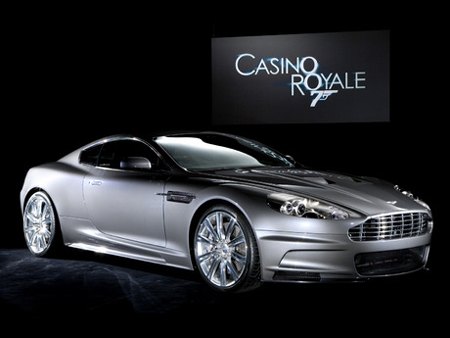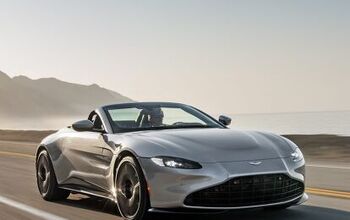Aston Martin RX
In 1984, an inebriated Henry Ford II met Victor Gauntlett in a London bar. Gauntlet controlled Aston Martin, a venerable British manufacturer of race cars and gentlemen’s sports sedans. Aston's sales were in the tank and there was no money to develop new models. “For a lousy $15 million, I’d sell the whole thing” Gauntlett said. Ford looked at his drinking buddy Walter Hayes and said, “Wouldn’t that shake ‘em up back in Dearborn?” In ’86, Ford bought 75% of Aston’s shares. In' 94, they bought the rest. Despite the fact that FoMoCo's investment has just come right, it's auction hammer time. So what's next for Aston?
Ford spent billions remaking Aston Martin into a modern car company, complete with reasonably reliable products and a up-to-date design, development, production and distribution process. Aston’s financial and manufacturing problems were resolved, and a few outstanding cars produced. The DB9 and Vanquish, for example, are worthy successors to the DB5’s and 6’s favored by Britain’s most famous (if fictional) spy. This year, after forty years of red ink, Aston finally turned a profit.
Although the brand gained profitability, something was lost in translation: exclusivity. Last year, Aston Martin sold 4500 vehicles. The company's latest model, the Vantage V8, clocks in at a relatively inexpensive $110k. What’s more (lots more) the company plans on producing 3000 examples of their “baby Aston.” This is exactly the sort of over-reaching brand extension you’d expect from the folks who tried to sell the world a Jaguar that’s a lightly dressed Ford Mondeo and a Lincoln Zephyr that’s nothing more than a tarted-up Ford Fusion. Ford has amply demonstrated that no one in the company save Alan Mullaly (owner of the new Lexus 460) truly understands luxury cars and their rich customers.
Now that Aston Martin is on the block, its new owners should note that the brand’s revival is a relatively simple matter. All that’s required is a quick and decisive return to the upper stratosphere. First, the Vantage V8 should be retired. While car critics have welcomed the model with open arms (aside from our Mr. Shoemaker), there is no evidence that any of these reviews have been written by an enthusiast with an annual income of at least $1m and/or assets above $20m (aside, perhaps, from our Mr. Shoemaker). In a world of affordable Mercs, Bimmers, Bentleys, Maseratis and Porsches, Aston Martin should stand above the fray as an obscure object of desire. In other words, it should be REALLY expensive.
To that end, Aston Martin should take the DB9 ($165k), Rapide ($200k est.) and the Vanquish ($255k) even further upmarket. Ferrari regularly markets cars that cost twice as much as a DB9, and sells every one, often years before they get around to making them. The recent Zagato coupe and the upcoming DBS (only 300 due to be built) are perfect examples of the "car too far" the company should produce. A $500k Aston (or 50) would draw wealthy pistonheads to Aston showrooms like moths to a flame-surfaced BMW.
Next, the moth-eaten showrooms must be upgraded. To their credit, Aston Martin has started to upgrade their dealerships to yacht purchasing levels. But too many Aston showrooms are still annexes to the local Jaguar dealer. Asking multi-millionaires to rub shoulders with plumbers who just bought a $30k Jaguar is simply not on.
Aston Martin should also exploit their heritage. Their rich racing history seems to have been completely forgotten during the Ford years. The Royal connection also needs more play. Prince Charles might be perceived as a bit of an old Fuddy Duddy by young people, but Aston buyers aren’t generally young, and Aston’s Royal Warrant is a literally invaluable marketing tool.
Ressurecting Lagonda is the final part of the Aston Martin revival strategy. Although I recommended killing the V8 Vantage, it could serve as the first Lagonda. A Lagonda that catered to low-end luxury sports car buyers could help preserve Aston Martin's identity as a truly aspirational brand. The marketing strategy worked well enough back when LaSalle introduced less affluent customers to the Cadillac aura, without sullying the Cadillac brand. Today's Maserati is a stepping stone to Ferrari, just as the LaSalle primed buyers for the leap to a Cadillac. A Lagonda to Aston transition would work a treat, for both.
Ford is reportedly asking $1 billion for Aston Martin. Another valuation, 100 times earnings, would value the English car brand at $1 million. For a price somewhere in between, and a billion or so in additional investment, savvy investors could return Aston Martin to its upmarket roots, beat Ferrari at its own game, merchandise for millions and show Ford exactly what they pissed– I mean, missed.
More by Bob Elton
Latest Car Reviews
Read moreLatest Product Reviews
Read moreRecent Comments
- ToolGuy TG likes price reductions.
- ToolGuy I could go for a Mustang with a Subaru powertrain. (Maybe some additional ground clearance.)
- ToolGuy Does Tim Healey care about TTAC? 😉
- ToolGuy I am slashing my food budget by 1%.
- ToolGuy TG grows skeptical about his government protecting him from bad decisions.


































Comments
Join the conversation
Its simple supply and demand - is there demand for the car? is there enough supply to meet it? that's going to determine price, and in the end, profitability for example, the v8 vantage has a pretty big supply and not much demand (you'd have to be out of your mind to buy one over a porsche 911 or a z06) but if its priced way beyond what the market will bear, they're not going to sell the cars frankly, they need to make cars people WANT and I can't find a reason to want any of their vehicles - there's something better in every price range, no matter how exclusive the aston seems.
Then I guess I must be one of those guys who's out of his mind - I ordered my V8 Vantage today! And I never, for even a second, considered a 911 or a Corvette!